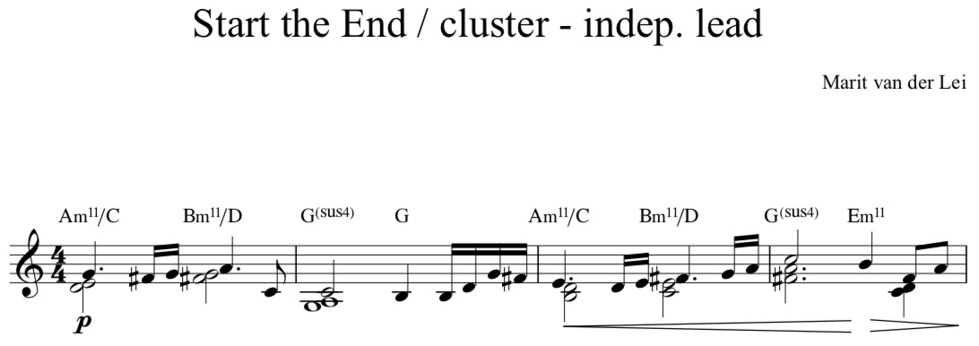4. Voicings………………………..…………………………..……………
When arranging for a 3 part horn section, you may come across different types of voicings that create different sounds and feelings to your music. I want to tell you something short about these voicings.3
4.1 Close position: rules…..……..………………
Setting up a voicing in close position requires the following:
- “hanging” pitches below the melody, taking the pitches of the used chord.
- A cluster on top (an interval of a second), is not desirable. This will interfere with the melody.
- 4 part solo techniques like drop 2, drop 3 and drop 2+4 obviously does not work
This is a pretty traditional way of voicing, 4 when analyzing old Count Basie bigband charts we can see a 4 part with a doubled lead being played by all the horns.
4.2 Voicings in seconds (clusters): rules………………………..
Voicings in clusters give a clear dissonant sound to a voicing. This works well when you have repeating pitches (it gives a percussive feel to the part), or in case of a melody existing of long notes. This type of voicing is less effective when voicing a (faster) pitch shifting melody. The compromise we are often making when voicing in clusters, lays in the completeness of the chord sound.
Setting up a voicing in close position requires the following:
- Both intervals have to be 2nds
- The 3rd of the 7th may be missing, as long as the chord sound is implied. (For example: 7 when dominant, at least the minor3 in a minor chord, at least #11&3 at major7#11 chord, at least the 3rd and alterations)
- No b2 as an interval between the two topvoices. Melody will get interfered.
We can also compromise in the outspokenness of the voicing. We then get a similar sounding voicing: the omit voicing. We come to this voicing when following the next steps:
- Create a four-way close position.
- Omit one pitch in a way that creates one second interval and one larger interval (staying in the octave)
Another specific colour is the voicing with a minor second with a minor third on top. This one also originates in the omit type of voicings. Possible options to use this type of voicings are, among others:
When the melody is:- minor 7 in a minorMajor7/Chord
- 7 in a dom7 lydian/Chord
- Chord tones in a dim chord
- b9, #11, 5, b7 of dom7 octotonic
Below you will find the first song, start the end, arranged in clusters. There are different types of cluster- voicings I used, the omit voicing and the regular cluster. I would say everything is pretty possible. The only point where in this arrangement, this type of voicing really does not work, is at the D7sus4(add3) chord. This
is such a typical chord sound, which is pretty impossible to create in a cluster setting.
4.3 Voicings in fourths: rules …..………………………………..
Voicings in fourths are relatively open voicings, which create a very resonant and mildly dissonant effect. They are widely used in modern jazz voicings.
Setting up a voicing in close position requires the following:
- Both intervals has to be fourths. Inversions are possible.*
- The 3rd of the 7th may be missing, as long as the c
- hord sound is implied. (For example: 7 when dominant, at least the minor3 in a minor chord, at least #11&3 at major7#11 chord, at least the 3rd and alterations)
- No minor 9 intervalls.
- In tonal harmony: no “avoidnotes”, in modal harmony, there can be.
- Inversions may look like this:
Fourth + fourth
2nd + fourth
Fourth + 2nd
b2 + #4
A #4 and a b2 is not successful, this will obscure the melody.
Voicings in fourths that are ambigu because they lack the 3rd and/or 7 are most effective when they are used before or after a clear “chordsound -confirming” voicing. A clear movement in the bass can also help.
4.4 Upperstructure triads: rules ..……………………………….
Upperstructure triads are voicings that can be used to create a strong colorful sound. As the name suggest, the voicing has to be a triad, inverted or not.
Setting up a voicing in UST requires the following:
- Has to be a minor or major triad
- Rhythm section has to provide a strong chord sound.
- Has to contain at least 1 tension.
Voicings UST are most effective when they are used before or after a clear “chordsound -confirming” voicing. A clear movement in the bass can also help.
In general, the chord sound is not confirmed. This is a very specific sound that does not always work well. When solely using this type of voicing, it does not provide a very stable sound. This may or may not be something you are looking for.
4.5 Spreads: rules ..………………………………………………..
In close position you “hang” your chord sounds below the lead melody. With spread voicings, you start at the bottom and work your way up. This is a type of voicing you use for your horn arrangements storing at lease 5 horns. Technically speaking, this thus is not a type of voicing you use for your horn arrangement, starring 3 horns.
When creating a spread voicing, you are opting for a full sound with a full, rich sound with a lot of “bottom”. Maybe you could create this sound with a “wider” voicing of your chord with just 3 part, but I think this will effect blending too much, because there will be a lot of missing parts between the pitches you do have. I will see if this statement is true in the arrangement I made for “Start The End”, where in bar 12 the intervals between the parts are larger then a 4th.
3 Pease, Ted. Pullig, Ken. (2001) Modern jazz Voicings: Arranging for small and medium ensembles. Boston, USA: Berklee Press
4 Statement of Henk Huizinga during the arranging lessons.



